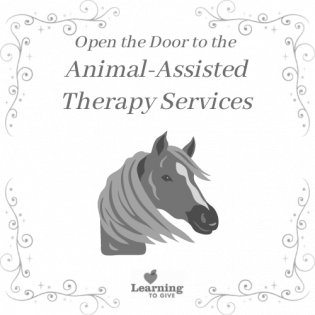Open the Door to Animal-Assisted Therapy Services
The "Open Doors to Your Community" project is a virtual door that guides young people to the actual door of local resources so they can learn about their community, take action, and build connections and understanding of their roles in the community.
What Is the Purpose of an Animal-Assisted Therapy Center?
Horses, dogs, and other animals have a calming effect on people. People with anxiety, mental illness, or physical or neurological disabilities can spend time with animals giving and receiving love and care. They build responsibility or skills when they help keep their space clean or give them exercise. Sometimes therapy dogs are simply present for petting. Riding a horse can help people build muscle and balance.
Meet a Horse Therapy Trainer
In this brief video, we meet Autumn Zick, president of the Therapeutic Equestrian Center (TEC). She shares stories and information about the power of horses to heal people with anxiety and mental or physical disabilities. They have school programs and a summer horse camp for kids. They teach horse care and riding skills, and provide a safe place to develop relationships with horses and people. Young people engage in their program as volunteers as well .
Contact Your Local Animal-Assisted Therapy Center
There are many types of animal-assisted therapy. Look up the contact information for nonprofits and programs in your community where people are matched with horses, dogs, and other animals who provide love and care when people are most vulnerable. Call to set up a phone or in-person interview so you can learn about their services. Tell them you'd like to learn more about the work of animal-assisted therapy and ways you can get involved or volunteer to help their mission. Ask for 30 minutes or an hour of their time. The Interview Script linked here and below can help you make the call.
Interview Questions
These questions can help you learn about your community and ways you can get involved.
- What is the main purpose of animal-assisted therapy? This may be its mission or vision.
- What are some challenges that animals can help people manage? What are the different reasons people are matched with animals?
- What are some things people can do to volunteer?
- What are the traits of an animal who qualifies as a therapy animal?
Take Action in Your Community
Reflect on the importance of services for people with disabilities or experiencing anxiety or loneliness in the community. What can you do to get involved? Your voice and time matter. The resources below can help you plan a project.
The best service-learning projects guide us to gain and use knowledge, are led by youth voice and passion, address a need, and develop connections with local resources over time.
 Learning to Give Issue Area Toolkits include background on the issue, community connections, lessons and activities, project ideas, and planning guides. Check out the Neuro and Physical Diversity toolkit. This lesson called No Boundaries guides learners to identify differences as strengths.
Learning to Give Issue Area Toolkits include background on the issue, community connections, lessons and activities, project ideas, and planning guides. Check out the Neuro and Physical Diversity toolkit. This lesson called No Boundaries guides learners to identify differences as strengths.
 Learning to Give Service Sparks guides provide directions for generous actions that encourage youth voice and promote the common good. Young people can make an Advocacy Poster to raise awareness of the emotional and social needs of young people.
Learning to Give Service Sparks guides provide directions for generous actions that encourage youth voice and promote the common good. Young people can make an Advocacy Poster to raise awareness of the emotional and social needs of young people.
 Learning to Give Literature guides combine selected literature with thought-provoking discussions and activities that teach about giving and civic engagement. The Just Ask literature guide provides discussion questions and activities to celebrate differences and bring out the themes of self-awareness and respect for self and others who make our world more vibrant.
Learning to Give Literature guides combine selected literature with thought-provoking discussions and activities that teach about giving and civic engagement. The Just Ask literature guide provides discussion questions and activities to celebrate differences and bring out the themes of self-awareness and respect for self and others who make our world more vibrant.
More about Animals and Health
Fun Facts:
- Animal therapy can improve someone's motor skills, self-esteem, and willingness to join in activities.
- Animals can make people feel happier and decrease loneliness and anxiety.
- Children can learn empathy and nurturing skills by interacting with animals.
- Animals can be found in chemotherapy rooms, retirement homes, doctors' offices, schools, and airports - anywhere people experience anxiety.
- People with Autism or hearing or vision loss can sometimes communicate more easily with an animal.
- There are over 500,000 service animals in the U.S. who help with physical and mental issues.
What You Can Do!
- Volunteers can help with chores wherever therapy animals live or visit.
- Fundraising or raising awareness of a program can help provide more services.
- Donate food, supplies, and time to support animal therapy nonprofits.
- Be a guardian home for therapy animals, caring for them when they are not working.
